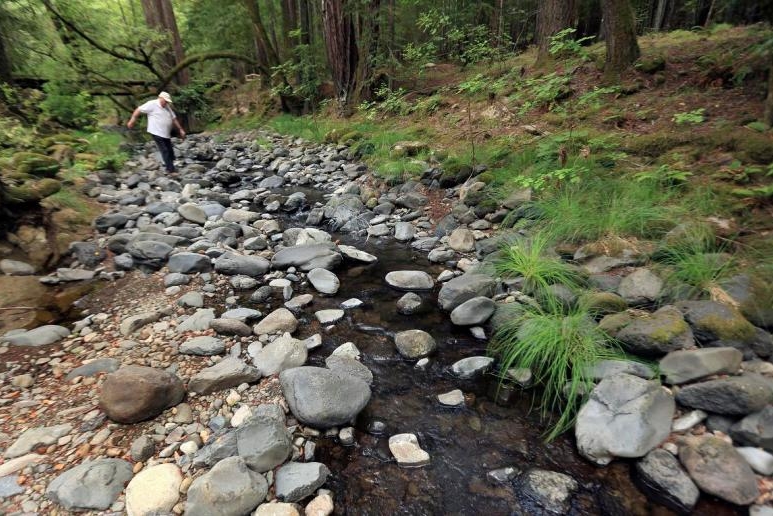Increase summer stream flows
Salmon and steelhead are in many of California’s stream systems year-round. Climate change and increased human water use are drying up streams in the summer, depriving salmon and steelhead of their summer stream habitat.
 Low water levels in Mark West Creek, a tributary of the Russian River near Santa Rosa © Kent Porter/Santa Rosa Press Democrat via AP
Low water levels in Mark West Creek, a tributary of the Russian River near Santa Rosa © Kent Porter/Santa Rosa Press Democrat via AP
The Problem
Water is a precious resource, utilized for many human purposes including drinking water, agriculture and industry. These uses can conflict directly with the needs of salmon, steelhead and other stream-dwelling species. This conflict is especially dramatic during the summer when water diversions for human use take most of the water when it is least abundant, often leaving salmon high and dry or struggling to survive.
 Chinook and coho salmon swimming in the Elk River, a Humboldt Bay tributary © Thomas Dunklin
Chinook and coho salmon swimming in the Elk River, a Humboldt Bay tributary © Thomas Dunklin
The Solution
Reduce and adjust water use during the summer
Ensuring water remains instream for fish requires a variety of tactics. Reducing water use through improved efficiency is always good. Also, the salmon conservation community is working with landowners to protect water in streams from overuse and to help landowners take and store water during the winter — when it is abundant — so they and the salmon have the water they need in the summer.
Examples
Resources
Check out The Nature Conservancy’s Guide to California Water Rights for Small Water Users for more information on California water rights law and to find out how smaller water users can meet their own water needs without relying on larger entities to deliver water to them.
If you’re diverting water from a spring or stream, you need to be informed about your water rights and responsibilities. The Salmon Restoration Federation has extensive background materials, guidance and contact information for landowners regarding their water rights on their Water Rights Education Program webpage.
The Klamath Resource Information System (KRIS) pulls together maps, data tables, charts, photographs, and bibliographic resources into a PC-based computer program. For any designated watershed, KRIS organizes information relevant to fisheries and water quality so that it can be shared quickly and easily among agencies, private landowners, and citizens. Visit the Stream Flow page on their website for a definition of “stream flow” and other helpful information.



